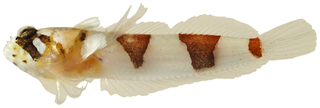
Citharichthys is a genus of flatfish in the large-tooth flounder family, Paralichthyidae. They have both eyes on the left sides of their heads. They are native to the oceans around the Americas, with a single species, C. stampflii off the West African coast. Most are found in relatively shallow depths, but the genus also includes species found in deep water and species that enter fresh water.

Ophichthidae is a family of fish in the order Anguilliformes, commonly known as the snake eels. The term "Ophichthidae" comes from Greek ophis ("serpent") and ichthys ("fish"). Snake eels are also burrowing eels, they are named for their physical appearance, they have long, cylindrical snakelike bodies. This family is found worldwide in tropical to warm temperate waters. They inhabit a wide range of habitats, from coastal shallows and even rivers, to depths of above 800 m (2,600 ft). Most species are bottom dwellers, hiding in mud or sand to capture their prey of crustaceans and small fish, but some are pelagic.
Dactylagnus is a genus of sand stargazers, found in the eastern central Pacific and western central Atlantic Ocean.
Gillellus is a genus of sand stargazers, found in the eastern central Pacific Ocean and western central Atlantic Ocean.
Myxodagnus is a genus of sand stargazers, native to the Pacific and Atlantic coastal waters of the Americas.

Platygillellus is a genus of sand stargazers native to the Atlantic and Pacific coasts of the Americas.
Dactyloscopus amnis, the riverine stargazer, is a species of sand stargazer native to the Pacific coastal waters of Mexico where it is found in both marine and brackish water habitats.
Dactyloscopus boehlkei is a species of sand stargazer native to the coastal waters around the Bahamas, Cuba and the Lesser Antilles where it can be found at depths of from 0 to 8 metres. It can reach a maximum length of 5.5 centimetres (2.2 in) SL. The specific name honours the American ichthyologist James Erwin Böhlke (1930-1982) who was curator of fishes at the Academy of Natural Sciences of Philadelphia.

Dactyloscopus byersi, the notchtail stargazer, is a species of sand stargazer native to the Pacific coast of Mexico to Panama where it can be found at depths of from 0 to 2 metres. It can reach a maximum length of 5 centimetres (2.0 in) NG. The specific name honours Major and Mrs. Joseph Byers, about whom no other information is available, since the name honours two people it should be Dactyloscopus byersorum.
Dactyloscopus comptus is a species of sand stargazer native to the coastal waters of the Bahamas and possibly Puerto Rico and the Virgin Islands. It can reach a maximum length of 3.9 centimetres (1.5 in) SL.

Dactyloscopus crossotus, the bigeye stargazer, is a species of sand stargazer native to the coastal Atlantic waters of Florida, United States and from the Bahamas to Brazil where it prefers sandy beaches at depths of from 0 to 3 metres, occasionally down to 8 metres (26 ft). It buries itself in the sand to ambush prey, leaving only its eyes, mouth and nose exposed. It can reach a maximum length of 7.5 centimetres (3.0 in) TL.
Dactyloscopus foraminosus, the reticulate stargazer, is a species of sand stargazer native to the coastal waters of Brazil where it can be found at depths of from 11 to 79 metres. This species may also occur off the coast of Florida, United States. It can reach a maximum length of 7.9 centimetres (3.1 in) NG.
Dactyloscopus lacteus, the also known as the milky sand stargazer, is a species of sand stargazer endemic to the Galapagos Islands where it is the only species of Dactyloscopus known to occur there, and is a common fish in its region. It can be found in tide pools and sandy shores at depths of from 2 to 9 metres. It can grow to reach a maximum length of 5 centimetres (2.0 in) SL.
Dactyloscopus lunaticus, the moonstruck stargazer, is a species of sand stargazer native to the Pacific coast of Central America from southern Baja California to the Gulf of Panama where it can be found at depths down to 60 metres (200 ft).
Dactyloscopus metoecus, the Mexican stargazer, is a species of sand stargazer native to the Pacific coast of Mexico where it can be found at depths of from 0 to 7 metres.
Dactyloscopus minutus, the tiny stargazer, is a species of sand stargazer native to the Pacific coast of Mexico where it can be found at depths of from 0 to 2 metres.
Dactyloscopus moorei, the speckled stargazer, is a species of sand stargazer native to the Atlantic and Gulf coasts of the United States from North Carolina to Texas where it can be found on sandy bottoms at depths of from 3 to 35 metres. This species can reach a length of 8 centimetres (3.1 in) TL. The specific name honours the American archaeologist Clarence Bloomfield Moore (1852-1936).
Dactyloscopus pectoralis, the whitesaddle stargazer, is a species of sand stargazer native to the Pacific coast of Baja California, Mexico and the Gulf of Mexico. It can reach a maximum length of 5.2 centimetres (2.0 in) TL.
Dactyloscopus tridigitatus, the sand stargazer, is a species of sand stargazer native to the Atlantic coasts of the Americas from Florida, United States to Brazil as well as in the Caribbean Ocean and the Gulf of Mexico. It is found in sandy areas around reefs at depths of from 0 to 29 metres. It is an ambush predator, burying itself nearly completely in the sand and attacking prey animals that happen by. It can reach a maximum length of 9 centimetres (3.5 in) TL.

Atherinella is a genus of Neotropical silversides from freshwater, brackish and marine habitats in Mexico, Central America and South America.






